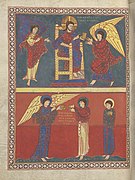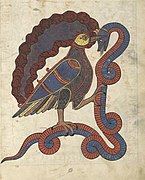
The Saint-Sever Beatus, also known as the Apocalypse of Saint-Sever (Paris, Bibliothèque Nationale, MS lat. 8878), is a Romanesque Illuminated manuscript from the 11th century.[1][2] The manuscript was made at Saint-Sever Abbey, then in the Duchy of Gascony, under the direction of Gregory of Montaner, abbot between 1028 and 1072. It is believed that the primary artist-scribe who illustrated the manuscript was Stephanus Garsia (who signed his name on folio 6), working alongside other unnamed individuals.[3]
The manuscript contains the Commentary on the Apocalypse of Beatus of Liébana, a commentary on Daniel by Saint Jerome and a treatise on the Virgin Mary by Saint Ildefonsus.[4][5] Parts of it are displayed in the Musée des Jacobins in Saint-Sever.
Gallery[edit]
-
Frontispiece of the Beatus
-
Decorated initial
-
Genealogy of Jesus Christ
-
Angel transmitting the revelation of the apocalypse to John
-
Rain of fire and blood
-
Bird victorious over the serpent
-
Angel throwing a dragon into the abyss
References[edit]
- ^ Sáenz, Sandra; Pérez, López (2016), "The Image of France in the Beatus Map of Saint-Sever*", Space in the Medieval West, doi:10.4324/9781315610115, ISBN 978-1-315-61011-5, retrieved 2023-03-02
- ^ Lewis, Suzanne (2003). "Review of The Illustrated Beatus: A Corpus of the Illustrations of the Commentary on the Apocalypse, 3: The Tenth and Eleventh Centuries". Speculum. 78 (3): 1014–1016. doi:10.1017/S0038713400132506. ISSN 0038-7134. JSTOR 20060885.
- ^ Wolfe, Shiela Pugh (1972). Christus Traditor: The Traditiones on the Evangelist Pages of the Beatus of St. Sever. Ohio State University.
- ^ Duzer, Chet Van; Dines, Ilya (2016-01-01). 1 Description of Huntington HM 83. Brill. ISBN 978-90-04-30727-8.
- ^ Lecaque, Thomas (2017-01-01). 5 Reading Raymond: The Bible of Le Puy, the Cathedral Library and the Literary Background of the Liber of Raymond of Aguilers. Brill. ISBN 978-90-04-34121-0.
External links[edit]
- Information and many pictures
- Facsimile edition, with information on the Commentary on the Apocalypse and sample illustrations










Well, that’s interesting to know that Psilotum nudum are known as whisk ferns. Psilotum nudum is the commoner species of the two. While the P. flaccidum is a rare species and is found in the tropical islands. Both the species are usually epiphytic in habit and grow upon tree ferns. These species may also be terrestrial and grow in humus or in the crevices of the rocks.
View the detailed Guide of Psilotum nudum: Detailed Study Of Psilotum Nudum (Whisk Fern), Classification, Anatomy, Reproduction